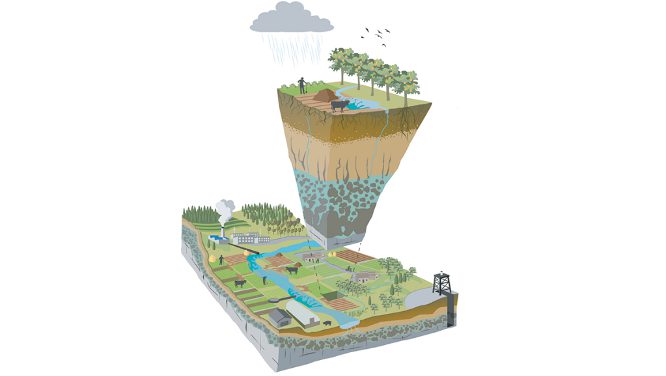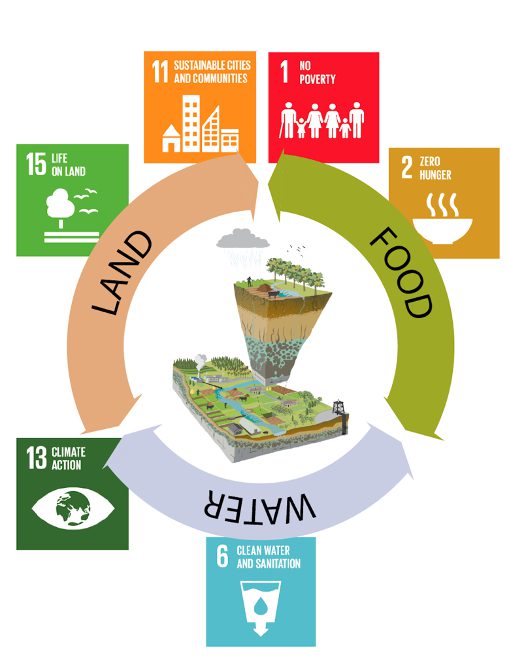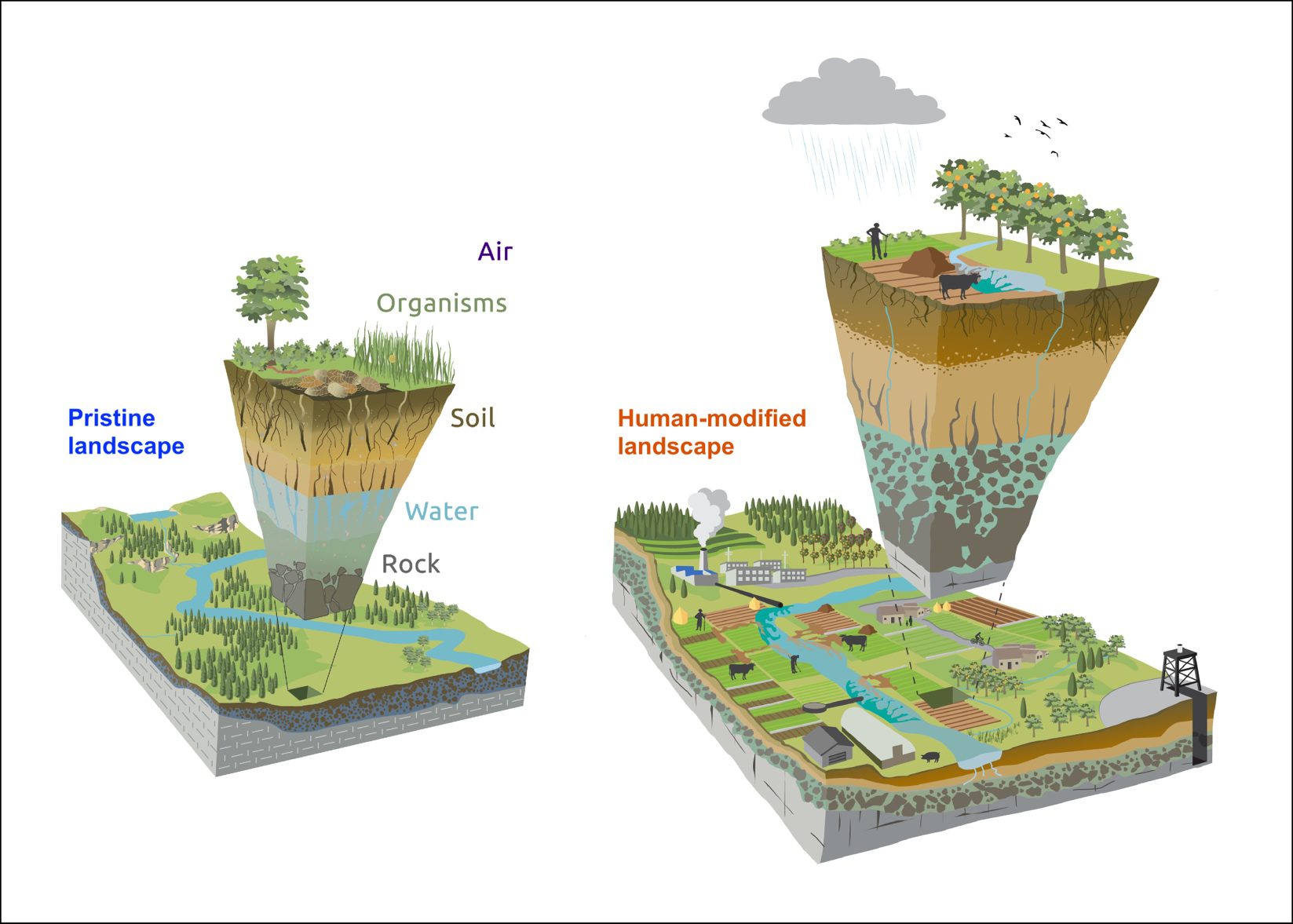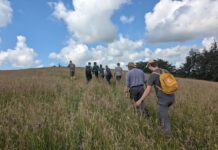
Future plans to tackle the climate change’s impacts on food security must integrate local knowledge to help preserve the Earth’s critical zone, experts have warned.
The critical zone is the thin layer of the planet’s surface that stretches from the roots of drinking water aquifers to the tops of plants and trees. It supports and sustains animal, and plant life by regulating the flow of water, greenhouse gases, nutrients and energy.
Access to food, drinking water and clean air depend on a well-functioning critical zone, but decades of human activity have degraded the zone’s condition around the world.
In a new paper published today (Monday 18 September) in the American Geophysical Union’s journal Earth’s Future, researchers from the UK and China outline how their experience of working with farmers on land heavily altered by human activity has shown how the critical zone can be better managed and protected.
Their insights are summarised in a new diagram, which seeks to visually convey human impact on the Earth’s critical zone more clearly than ever before. The researchers suggest that the new diagram should replace a widely used, more simplified graphic, introduced in 2007, which focused on the natural processes that shape the critical zone without addressing human impact on landscapes.
The new diagram is intended for use by academics across a range of fields for research and teaching purposes, by government agencies that fund science and landscape management, and in fundamental teaching resources such as textbooks. It more clearly shows how human activities like farming, mining, forestry and industry can contaminate water, cause soil erosion, and pollute the atmosphere.
Professor Larissa Naylor, of the University of Glasgow’s School of Geographical & Earth Sciences, led the design of the new diagram and is the paper’s corresponding author. She said: “Humans have been heavily modifying the Earth for nearly 12,000 years now through agriculture, mining, forestry, and urbanisation.”
“We’ve changed our environment to such an extent that we have created a new geological epoch through the alterations we’ve made to the critical zone. In this new era, which many now call the Anthropocene, the impacts of our activities permeate down through the soil into the geology deep below and up into the local atmosphere above, forcing natural cycles to change.”
Co-author Ganlin Zhang, of the Institute of Soil Science at the Chinese Academy of Sciences in Nanjing, China, added: “We can see the effects of those changes in faster rates of erosion that drive soil degradation, for example, or through the greenhouse gas emissions that cause climate change. This directly impacts the ecosystems that sustain human life, including the livelihoods of farmers and local communities.”
The need to refine and redesign the existing approach to critical zone science became apparent to the research team during work at the four critical zone observatories in China. In recent decades, a series of critical zone observatories, or CZOs, have been established around the world to act as ‘living labs’ for critical zone science.
The researchers set out to see how policy changes from the Chinese government, which aimed to restore degraded landscapes and reduce the use of synthetic fertilisers, had affected the functioning of the land across the CZOs. They also conducted research to find out how the farmers learned about the new policies, shared information with each other on best practice, and adapted their approach to land management.
Professor Jennifer Dungait, of the University of Exeter and Scotland’s Rural College (SRUC) is joint lead author of the paper. She said: “Farmers and local communities are at the front line of local land management, with a wealth of knowledge about how to farm productively and sustainably in their home environment. We showed that this knowledge is vital to improving our scientific understanding of critical zone systems.”
Professor Paul Hallett, of the University of Aberdeen, a co-author of the paper, added: “High-quality critical zone science is vital to helping governments, charities, funders and other organisations make important decisions about how we can slow the degradation of natural systems so that it can cope better with the challenges of climate change.”

Professor Naylor said: “In order to help them make the best decisions, we need to draw on this local knowledge, working with communities to design and share interdisciplinary science in a way that directly benefits local communities and is understandable to general audiences. That’s what this new diagram sets out to do by making human impacts on the critical zone more clearly visible. Previous diagrams had focused on a theoretical, pristine natural environment, which were less engaged with the physical reality of heavily human-modified environments that are lived in and shaped by local communities.”
Professor Timothy Quine, of the University of Exeter, is another co-author of the paper. He said: “The insights gained from our work with Chinese farmers have been key to developing our new conceptual diagram, which represents the wide array of human impacts on rural to peri-urban terrestrial landscapes. It more clearly demonstrates the fundamental role the human technosphere plays in shaping the Earth, its landscapes and the ecosystems that sustain life for humans and wildlife that provide critical life-sustaining functions, such as pollination.”
“It thus represents a critical step-change in visually conveying the impacts of catchment-scale human activities in the Anthropocene epoch on landscape change and ecosystem degradation.”
Professor Naylor added: “A key lesson learned is that local people show resilience in sustaining their livelihoods in stressed, degraded ecosystems and that this knowledge is fundamental to interpreting scientific results in human-modified landscapes. In short, we understood our scientific findings better by linking them with how local people are using their land.”
“We simply can’t use critical zone science to properly deliver the United Nations’ Sustainable Development Goals and planetary health without involving local people, and without acknowledging the impact that humans have already had on the critical zone. Local knowledge will help ensure that critical zone science can effectively support sustainable socio-economic development by improving the ecosystems of places where people live and work.”
“Our hope is that this research will act as a beacon for other environmental scientists to guide the way to a more integrated approach to the conservation of our environment, and help governments and communities more effectively align with scientists to deliver better outcomes at local, national and global levels.”
The research is published in the journal Earth’s Future. A second paper, published simultaneously in the same journal, further outlines lessons from the researchers’ work with smallholder farmers in China and suggests new social science approaches to understanding the learning preferences of local people involved in Critical Zone Observatories.
Contributors to the paper included researchers from the University of Glasgow, the University of Aberdeen, the University of Exeter, SRUC – Scotland’s Rural College, the University of Stirling and Queen’s University Belfast, along with colleagues from Peking University, Guizhou Medical University and the Chinese Academy of Sciences in China.
The team’s paper is titled ‘Achieving sustainable Earth futures in the Anthropocene by including local communities in Critical Zone Science’.
The research was supported by funding from the Natural Environmental Research Council, China CZO and MIDST-CZO projects, along with the National Natural Science Foundation of China.









